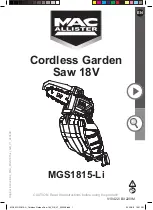
14 GB
- Apply only as much pressure as is required
for sawing. If there is excessive pressure, the
sawing blade may bend and break.
- Switch the device off immediately if the
sawing blade jams.
Spread the saw cut out and pull the blade out
carefully.
- Always stand to the side of the saw when
working.
- Always make sure that the workplace is well
ventilated.
- Avoid over-stressing the device while working.
Regular Cuts
Verify the tool is not touching the work piece.
Then switch on.
Apply the shoe
1
to the work piece. Use even
pressure, advancing at a steady pace when
making your cut. You can make horizontal,
diagonal, or vertical cuts.
1
When you are finished, first pull the saw blade
out of the work piece before switching off the
power tool.
Plunge Cuts
Plunge cuts are very challenging and are associated
with a higher risk of injuries. Only use this technique
if you are familiar with it.
Plunge cuts may only be carried out in soft
materials such as wood or plasterboard and
with short blades (max. length 150 mm). There
is a risk of kickback and personal injury.
1. Place the front edge of the base plate
1
on
the work piece so that the saw blade
17
does
not touch the work piece.
17 1
2. Turn the device on and let the saw blade
17
slowly plunge into the work piece.
3. When the work piece depth has been cut
through, continue sawing as usual.
17 1
Flush cuts:
With elastic bi-metal saw blades you can separate
water pipes, for example, flush to the wall.
Make sure that the blade is always longer than
the pipe diameter. There is a risk of kickback
and personal injury.
Cleaning / Maintenance
Remove the battery pack from the device
before carrying out any work or transporting it.
If the device is switched on accidentally, there
is a danger of injury.















































